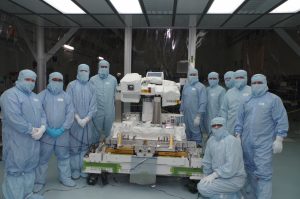
The instrument suite is called the Total and Spectral Solar Irradiance Sensor (TSIS-1) and was designed and built by LASP for NASA’s Goddard Space Flight Center in Greenbelt, Maryland. The contract value to LASP is $90 million and includes the instrument suite and an associated mission ground system in the LASP Space Technology Building on the CU Boulder East Campus Research Park.
TSIS-1 will launch on a commercial SpaceX Falcon 9 rocket carrying the Dragon cargo container for delivery to the International Space Station (ISS). It will monitor the total amount of sunlight hitting Earth, as well as how the light is distributed among the ultraviolet, visible, and infrared wavelengths.
Peter Pilewskie, LASP atmospheric scientist and lead scientist on the project, said TSIS will continue a 40-year record of measuring total solar radiation, the longest continuous climate record from space.
“The Sun drives all of Earth’s processes, from atmospheric and oceanic circulation to chemical and biological activity,” said Pilewskie, also a CU Boulder professor in the Department of Oceanic and Atmospheric Sciences (ATOC). “Trying to understand Earth’s climate without measuring the Sun is like trying to balance your checkbook without knowing your income. How the atmosphere responds to subtle changes in the Sun’s output helps us distinguish between natural and human influences on climate.”
Overall satellite measurements of the Sun from space have shown that changes in its radiation over time—during periods of both high and low solar activity—is only about 0.1 percent. While scientists believe changes in solar output cannot explain Earth’s recent warming, a longer dataset could reveal greater swings in solar radiation.
TSIS consists of two instruments: The Total Irradiance Monitor (TIM) that measures the total light coming from the Sun at all wavelengths, and the Spectral Irradiance Monitor (SIM) to measure how sunlight is distributed by wavelength. The latter is important because light at different wavelengths is absorbed by different parts of the planet’s atmosphere and surface, helping to determine how the Earth system responds to solar variability.
At its peak, the project involved about 30 scientists and engineers at LASP as well as another 300 people from Colorado and around the country, said TSIS-1 Project Manager Brian Boyle of LASP. All told, more than 1,000 people worked on TSIS in the past two decades. The mission, slated to run at least five years, also has involved about 15 to 20 CU Boulder students to date.



